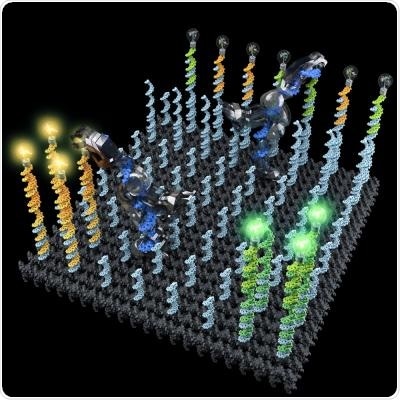Researchers at the California Institute of Technology have developed an autonomous molecular machine comprising a single strand of DNA that can move around, collect specific molecules and sort them into predefined locations. Furthermore, this nanobot has been designed in such a way that requires no external source of energy or instruction.

Credit: Demin Liu
Lulu Qian, assistant professor of bioengineering, and her team at the California Institute of Technology have created a microscopic machine from DNA that is able to independently perform multiple tasks. Inspired by the behavior of ants, the team have developed the first ever DNA machine.
Qian explained:
Just like electromechanical robots are sent off to faraway places, like Mars, we would like to send molecular robots to minuscule places where humans can't go, such as the bloodstream...Our goal was to design and build a molecular robot that could perform a sophisticated nanomechanical task: cargo sorting."
The creation of this DNA robot was ground-breaking, yet so simple. The nanobot is a continuous string of single-stranded DNA that is only 53 nucleotides long. It includes two ‘foot’ domains joined by a leg strand and a ‘hand’ domain at the end of an arm strand. Using specific strand displacement reactions, the DNA robot can move around amongst randomly scattered molecules and sort them by type into separate groups without requiring any external signals or energy input.
The nanobot randomly moved around a two-dimensional testing ground as its "feet" sections bound to complimentary DNA stands. Similarly, the cargo molecules bound to a complimentary DNA sequence on the robot's "hand". Another sequence on the "hand" recognised the target destination, causing it to release its cargo in a pre-designated area. In the reported experiment, the DNA robot picked up a molecule labelled with a fluorescent yellow dye and a second type of molecule tagged with a fluorescent pink dye.
It successfully moved the yellow-tagged molecules to one region of the test area and the pink-tagged molecules to a separate distinct region of the test area. The robot sorted three pink and three yellow molecules into their correct places over 24 hours. The task was completed more quickly when additional robots helped with the sorting. Although the random movement means the sorting is slow, it is made possible by a very simple robot design that requires very little energy.
The robot has so far only been shown to complete one specific task but it is feasible that, by giving the robots several different "hands", they could carry multiple molecules simultaneously. Furthermore, by using different robots several diverse sorting tasks could be undertaken in parallel.
The simple principles demonstrated in this research could thus be developed for a myriad of potential applications, such as using a DNA robot for synthesizing a therapeutic chemical from its constituent parts, or delivering a drug only when a specific signal is given in the bloodstream.